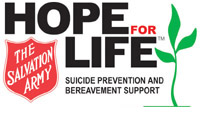
A new national 24 hour Hope Line was launched by the Salvation Army as part of their “Hope for Life” campaign to cut suicide rates and help us all spot the signs of depression.
The “Hope for Life” campaign also includes training programs for professionals as well as online training for individuals. Written by clinical psychologist Dr Paul Quinnett, the OPR (question, persuade, refer) program will show anyone – in less than one hour – how to spot the signs that someone around them may be considering suicide.
Salvation Army Envoy Alan Staines, who was awarded a Medal for the Order of Australia (OAM) for his work in this field, says that it is vital suicide prevention becomes everybody’s business.
“This is a major problem in Australia and it’s not going away. There were 1799 suicides in Australia in 2006. That’s 1799 too many. We can all do more. We must.”
Statistics show that one Australian commits suicide every 5 hours and that more people lose their lives to suicide than road accidents.
The Salvation Army says that the Hope line is for anyone who has been affected.
“In real terms for each tragic death another 8 people are often affected which means the ripple affect leads to around 16,000 Australians being affected buy suicide.” Mr Staines says.
Joseph Pizzolo lost his son Paul to suicide. “We all need to take this issue very seriously. If someone around you is talking about suicide in any way, listen to them. Offer advice and assistance before it’s too late” He says.
Warning signs include expressions of hopelessness, threats, talk or jokes about suicide, sudden mood swings, giving away possessions, withdrawal from family or friends, a change in sleeping patterns, excessive feelings of guilt or worthlessness and increased use of alcohol or drugs.
Mental Illness plays a major role in suicide related deaths but the Chair of the National Advisory Council on Suicide Prevention, Professor Ian Webster, says many other factors contribute too.
“Life problems can include – a mental disorder; a problem with alcohol or substance use; a breakdown in important relationships with a spouse or children; or a perceived failure in social roles; in essence major losses.” He says.
The Salvation Army hope that the campaign will help dispel common myths about suicide.
“There are far too many myths about suicide. It’s a myth to think only experts can prevent it. It’s a myth to think people who talk about suicide will not do it. It’s a myth to think you cannot stop suicide from happening. It’s a myth to think suicidal people only want to die. Many want to live a better, happier life. What they are saying is that they need help and relief from the intense emotional pain they are experiencing ” says Mr Staines.
Former ABC Journalist and media personality Sally Loane lost her brother to suicide and has spoken about her experiences in support of the campaign.
“The night I learned my brother John had taken his life, I dreamed about him. He was trying to talk to me in the dream and walk towards me, but it was one of those dreams where time was frozen, and neither of us could speak or touch. I woke up crying.”
“This was the beginning of a terrible new day when I no longer had a younger brother
who could entertain us with stories of his life as a vet, flying planes into remote north
Queensland properties to work with the cattlemen of the bush. It was also the start of a long and painful process of grieving for my mother, father and sister. There was no more John, no more brother, no more only son. We have precious memories and photographs, and the raw pain has faded with the years but there is no forgetting and certainly no "getting over it".”
If you need help please contact the Hope Line on 1300 467 354.
The Salvation Army website, www.suicideprevention.salvos.org.au, also contains details of agencies people can ring for support, as well as how to support someone affected by suicide.







